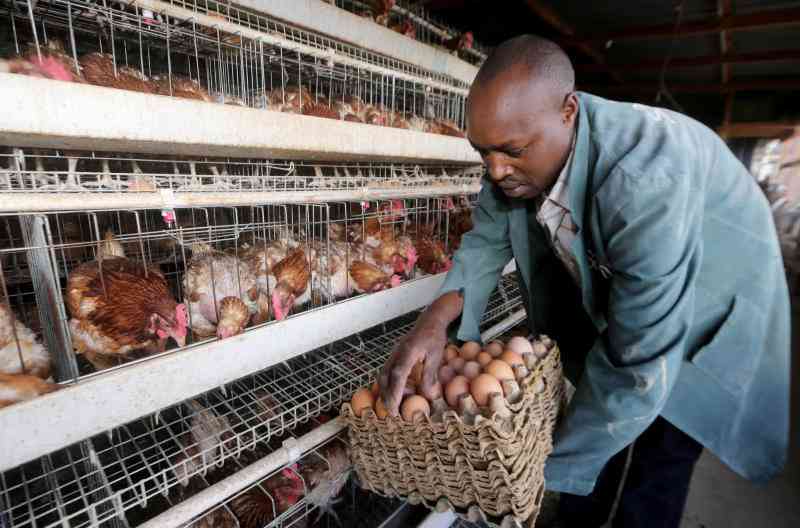Foot and mouth disease is a contagious infectious disease of cattle, sheep, goats and pigs caused by a virus.
This disease is transmitted through inhalation or ingestion of the virus from contaminated feeds and direct contact with infected animals.
The incubation period is between 4 to 10 days after the animals are infected. Infected animals shed the virus to materials they are in contact with or directly to other animals, therefore infecting them through the saliva, rupture of vesicles and blisters on the tongue and feet as well as discharges from the nose and by coughing.
Meat, milk and semen from infected animals can spread infection.
People transfer infection to other animals through movement from one place to another and also through vehicles moving from infected premises to other areas.
Common signs of foot and mouth disease in animals
- Animals develop a high fever, become weak and dejected, and emaciated. Mortality in young calves is very high since they have a lower immunity level.
- The blisters and vesicles between the toes, which rupture and get infected lead to severe lameness.
- A drop in milk production in cows
- The coat becomes rough and there are blisters and vesicles inside the mouth especially on the tongue.
- Cattle stop eating due to the pain due to the lesions in the mouth
- There is profuse salivation with long ropey strings of saliva, and a characteristic smacking of the lips
- Blisters form above and between the claws, and some blisters appear on the teats.
- Abortion is common
- Sheep and goat suffer a milder disease than cattle
- Pigs can also be affected by Foot and Mouth disease
Prevention and Control of FMD
- FMD occurrence should immediately be reported to veterinary authorities so that quarantine is instituted after the disease is confirmation
- Disinfect premises – the environment- and motor vehicle tires with appropriate disinfectant to curb further infections.
- Adhere to strict sanitary measures such as destruction of feed and beddings of infected animals should be observed.
- Vaccinate regularly. As a preventive measure a multivalent vaccine is usually administered every 6 months. Outbreaks have occurred following vaccination and have been attributed to the production of carrier animals. These are animals that have FMD but are not showing signs
How to treat FMD?
Foot and Mouth Disease has no medical treatment. However, you can show some tender love and care (TLC) to help your animals to recover faster using the following protocols:
- Give antibiotics by intramuscular injection to prevent secondary infection of the blisters. Avoid giving adult cattle, camels, sheep and goats antibiotics by mouth. It makes these animals sick by destroying essential bacteria in their rumens that are there as a vital part of the digestive process.
- Magadi soda is used for foot baths and wound treatment. It is effective against the virus.
- Keep the animals in the shade to shield them from the sun and give them plenty of water
- Avail soft feed such as green, soft, lush grass, which is better than hay as the blisters make it painful for the animals to eat. Molasses can be added to give the animals the much-needed energy.
Adapted from the textbooks of Large Animal Medicine.
Author: Dr. Paul R. N. Kangethe (BVM, UoN)
Email: [email protected]
Want to get latest farming tips and videos?
Join Us
 The Standard Group Plc is a multi-media organization
with investments in media platforms spanning newspaper print operations,
television, radio broadcasting, digital and online services. The Standard Group
is recognized as a leading multi-media house in Kenya with a key influence in
matters of national and international interest.
The Standard Group Plc is a multi-media organization
with investments in media platforms spanning newspaper print operations,
television, radio broadcasting, digital and online services. The Standard Group
is recognized as a leading multi-media house in Kenya with a key influence in
matters of national and international interest.
 The Standard Group Plc is a multi-media organization
with investments in media platforms spanning newspaper print operations,
television, radio broadcasting, digital and online services. The Standard Group
is recognized as a leading multi-media house in Kenya with a key influence in
matters of national and international interest.
The Standard Group Plc is a multi-media organization
with investments in media platforms spanning newspaper print operations,
television, radio broadcasting, digital and online services. The Standard Group
is recognized as a leading multi-media house in Kenya with a key influence in
matters of national and international interest.







